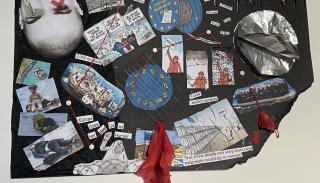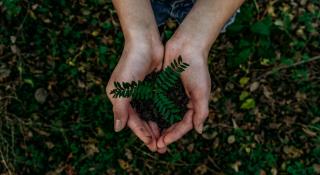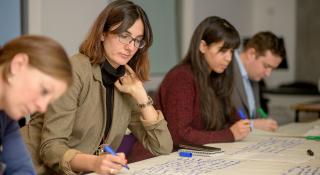
Breadcrumbs navigation
Creative pedagogy: teaching the international innovatively and intimately
Laura Mills was the winner of the 2023 Award for Distinguished Excellence in Teaching International Studies.
Like many scholars who position themselves at the ‘critical edge’ of the discipline, I make a commitment to engage with/in the international curiously, critically, and creatively. What is striking is how this commitment often manifests: many undo the discipline via research but then largely stay within the ‘safe’ confines of ‘traditional’ pedagogy and assessment. This makes little sense. Of course, we know that the discipline, and the academy overall, does not reward such investment in teaching. Even though the university would not, could not, exist without students. But – when we are engaging students as researchers – what does it mean when we extend this to our pedagogy?
Over the last few years, I have had the pleasure to design and deliver two modules on the global politics of everyday life – one undergraduate and one postgraduate – that incorporate ‘creative methodologies’ as integral elements to explore innovatively and intimately the international. My thanks go to dear friends and colleagues Shine Choi and Saara Särmä who generously shared their creative pedagogical practices and trailblazed some of these elements with their students in Finland, New Zealand, and the US. And to all those scholars within the discipline engaging in these creative practices and opening these possibilities for us.
Creative IR pedagogy is therefore a caring pedagogy. Creative IR pedagogy relies on an innovative but also intimate politics of teaching and learning the international by bringing students and educators together collectively, collaboratively, care-fully in mutual, co-productive teaching-learning spaces (see Motta & Bennett 2018). Such pedagogical work embodies bell hooks’ “engaged pedagogy” (1994), the belief that “our work is not merely to share information but to share in the intellectual and spiritual growth of our students” and “to provide the necessary conditions where learning can most deeply and intimately begin” (ibid.: 13).
hooks reminds us that “The classroom remains the most radical space of possibility in the academy.” Teaching the international innovatively and intimately through creative practices enables us “not only to imagine that the classroom could be exciting but that this excitement could co-exist with and even stimulate serious intellectual and/or academic engagement” (ibid.: 7). Far from ‘easy’ or ‘trivial’, creative IR practice enables difficult entanglements of everyday life and global politics to be vividly and vigorously interrogated (with students’ (un/re)creating of the international enacting deeply evocative encounters). Such excitement is therefore only possible through creation of community that is open and safe for vulnerability and experimentation. From the outset, we speak about giving space for/listening to/hearing/learning from each other’s diverse lived experiences of the everyday, the global, the political – and, in turn – reclaiming teaching-learning-being-knowing of the international.
The study of international relations has (often been positioned as) predominantly focused on supposedly ‘official’ actors, sites, and practices. But what about ‘ordinary’ individuals? What about ‘mundane’ practices and quotidian behaviours? How do their everyday lives fit into IR? Through these modules, students creatively explore these questions to reveal how everyday life and global politics are co-constitutive.
Whether sounds/silences, emotions, food, fashion, or travel, students creatively explore how these everyday objects, structures, and practices mutually constitute global power relations that are messy and complex and interrogate how they often bolster and (re)produce problematic logics of gender, race, class, militarism, and beyond. To do so, the modules introduce students to, and encourage them to engage in, alternative and creative ways of thinking, and alternative and creative sites and forms of scholarship, learning, and assessment. Students develop their critical thinking at the cutting edge of innovative and creative practice in IR by both exploring how scholars ‘do’ IR through a range of creative forms – film, narrative, (auto)ethnography, poetry, art, collage, photography, visuality, video remix, performance – and doing so themselves in their own explorations of how everyday life mutually constitutes global politics.
How is this creative and alternative way of thinking/knowing/doing IR enabled? The following sections – Composing, Creating, Curating – delineate three devices (also forms of assessment) deployed in the modules: the first two are in both modules – composition notebooks and creative pieces – and the third in the Masters-level module (although optional participation by undergraduate students is encouraged) – a curation.
Composing
Throughout the module, students use and produce a composition notebook (or, most often, notebooks). Based on award-winning cartoonist and academic Lynda Barry’s Syllabus, the composition notebook is what Barry terms a “catch-all” to collect samples from all elements of daily life (2014: 62). This includes students’ reading and seminar notes, ephemera of everyday life (tickets, leaflets, receipts), and five-minute daily diaries which, Barry argues, “teach you to hear, see and remember the world all around you” (ibid.: 61), thereby encouraging students to identify and consider how the everyday is co-constituted by/in the global. The more students buy-in to this process and space of possibility, the more enriching the composition notebook; they are therefore encouraged to take time and care in how they compose it – in their writing, structuring, visualising – to develop their critical thinking about the theoretical and conceptual engagements surrounding everyday life and global politics.
The books are small and light enough to be taken everywhere (in a bag, large pocket) so that these elements and observations of everyday life can be easily collected. Barry argues that through unexpected juxtapositions of these elements, “patterns start to emerge that can be very helpful in trying to understand what this thing” she calls “‘the back of the mind’ is up to” (ibid.: 62). She regards the composition notebook as “a place for the back of the mind to come forward” and, if students buy into the composition notebook throughout the semester, when it comes time to decide on the topic and design of their final essay, the composition notebook should “already contain the answer” (ibid.). It is incredible to see how a seemingly banal observation made in week two in the composition notebook becomes the seed for the whole topic of their final research essay and/or creative pieces.

Composition notebooks produced by St Andrews students from IR4570 Everyday Life and Global Politics and IR5066 The Global Politics of Everyday Life.
A student concern in early iterations of the module that the notebook was a ‘diary’, containing insights too intimate for evaluation and assessment, led to an open, collaborative reemphasis of the daily diary element as a very small part of the composition notebook which students may decide does not work as well for them. With the pandemic and online delivery, students then selected a sample of the different elements composing the notebook so they had full ownership of the book and what they chose to disclose or not. Above all, however, students are encouraged to see the composition notebook “as a place. The practice of developing a place not a thing” (Barry 2014: 194).
Within the modules, emphasis is placed on how composition notebooks work for students as:
- a mobile site of experimentation
- an on-hand source of/for creativity
- an active workspace for problem-solving
- and a tailored research tool
They are places to develop alternative ways to think – this is about observing, seeing, hearing, noticing and how all of this helps us critically reflect on how everyday life and global politics are intertwined.
Earlier this year, I received an email from a former student wanting to share a recent New York Times piece on Lynda Barry, but also that she was still using her composition notebook. Three years later. How she still gleans so much from it as a practice. How it encourages her to be an engaged citizen in/of the world. After sharing this story at the BISA Teaching and Learning Café at this year’s conference, it was a wonderful surprise to have one of the students from the first cohort, now a PhD candidate in Vienna, recounting that her composition notebook was also there with her and she continues to use it to shape her thinking/knowing/being (in) the international to this day. That is what pedagogy is for me – far from remaining confined to the classroom, it enables students to be critically minded and to go into the world thinking, feeling, knowing, doing in much more attuned ways.
Creating
Creative pieces – practicums – enable students to play with and materialise such spaces of possibility. This US term – borrowed from Shine Choi’s creative pedagogical practice at the University of Mississippi – denotes a form of study involving activities that enable the practical application of theoretical and conceptual knowledges. Selecting a different aspect of everyday life and a different creative ‘methodology’, students produce two practicums, small creative pieces that critically explore the co-constitution of everyday life and global politics, e.g. a rap written and performed critiquing the alt-right and dark web.
Students are not assessed on their drawing/camera shooting/collage-making skills, etc. Rather, this is about the understanding demonstrated; the critical reflection and methodological originality exhibited; and the critical insights of political logics at operation inspired by the theoretical and conceptual work that constitutes the course.
Students are given freedom and possibility to experiment, be bold and daring in their critical and creative explorations as these pieces are first submitted for formative feedback. Provided to students first in written form, we then meet individually to discuss. From the outset this is highlighted as a genuinely open space for them to take feedback on board – or not, due to the creative critical choices they have made – with the opportunity to incorporate it before final submission. I have been overwhelmed by the work they produce – the effort, creativity, criticality, care – for what is only a small percentage. I have been moved to tears by their work. I have helped several of them publish that work. But above all, students are crying out for this work as evidenced every year. In our conversations. In anonymous student feedback. In full module capacity (and more students emailing and doorstepping to express their desire to join the course than is possible).

“Refugees Without Refuge” by Paula Pérez; “The New Colossus” by Anna Goodwin; “Alternative Vogue” by Rebecca Hyrslova.
We have a diverse international student body. One student from Japan shared how for those with English as a second language, these methods had “levelled the playing field”. Students play to their strengths, choosing the aspects of everyday life they wish to critique, choosing the creative methods through which they believe they can best showcase that critical exploration, choosing the essay topic/questions that enables them to provide the most engaging/engaged response. Students, I remind them, are researchers, critical scholars in their own right. This encouragement promotes a real sense of ownership, of self in how they create and curate that research.
Curating
The course culminates in an event – an exhibition – that celebrates the creative work and practice that students have both created and committed themselves to. Selecting a methodology not featured in their practicums, PGT students produce an ‘alternative intervention’, a larger, deeper critical commentary on a further aspect of everyday life that, for example, unsettles everyday militarisation, global capitalist consumption, or racialised inequalities. In the final week of Candlemas (spring) semester, these interventions are exhibited in a ‘Candlemas Curation’, e.g. a narrative on militarisation at a polo match printed, displayed, recorded, and played on loop. The overall curation entails decisions around display, flow, thematic direction, with undergraduate students opting to exhibit their practicums coming under PGT students’ guidance. PGT students are the curators and are assessed on the curatorial choices of how to exhibit this work.

Alternative Interventions and ‘Candlemas Curation’.
In some ways, this presents a pedagogical dilemma – for while it is so rewarding to engage in this pedagogical practice, it is also difficult to assess creative work. Again, the intimate and innovative teaching-learning spaces of possibility that nurture vulnerability and openness enable such difficulties to be navigated. This involves an extensive but invaluable process, dedicating the early weeks of the module to our mutual exploration and engagement with and in creative practice where we are vulnerable, open together – collectively collaging, narrating, and experimenting. We also devote a large amount of time to probing and understanding the criteria that I developed to provide bounds (word counts, length, etc.) for each form of creative intervention. Such bounds cannot be so great that they would inhibit creativity and go against the very aim of this practice. It is vital to leave enough openness, freedom for students to do their best critical creative work.
Some of this incredible work is available to explore online. In 2021, as one of the inaugural winners of the University of St Andrews’ Entrepreneurial Education Fund, I was able to produce, with the grateful support of Research Associate Matt Warren, the website Everyday Life and Global Politics as a lasting resource. I have been awed by students’ extraordinary work and I hope you enjoy it also should you visit this space. My primary hope is to highlight how creative pedagogy around everyday life and global politics can provide more affective, immediate, and potent ways of understanding/being (in)/knowing the world.
Acknowledgements
I would like to thank the British Academy and CELPiE: Community for Evidence-Led Practice in Education, University of St Andrews for their support to attend the prize giving of the award via the British Academy ECRN Development Fund and the CELPiE Travel Fund. The CELPiE article from which this one draws can be found here.
References
Lynda Barry. 2014. Syllabus: Notes from an Accidental Professor. Montreal: Drawn and Quarterly.
bell hooks. 1994. Teaching to Transgress. Education as the practice of freedom. London: Routledge.
Sara C. Motta & Anna Bennett. 2018. “Pedagogies of care, care-full epistemological practice and ‘other’ caring subjectivities in enabling education,” Teaching in Higher Education, 23(5): 631-646.


